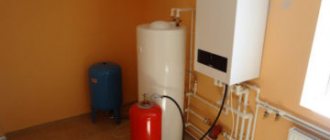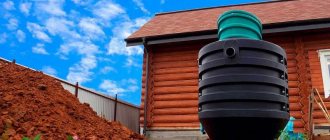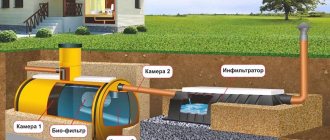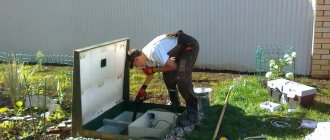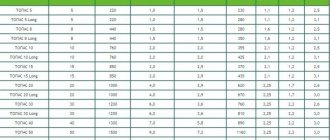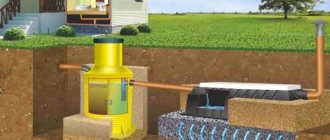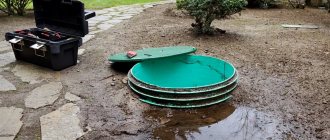17.12.2020
Sewerage
Editorial staff of the “New Place” website
Share
From this article you will learn
:
- Criteria for choosing an autonomous sewer system for a private house
- Cesspool in a private house
- Installation of septic tanks with a filtration well for a private house
- Autonomous sewage system in the form of a septic tank with a filtration field
- Septic tank with infiltrator in the sewer system
- Septic tank with biofilter for home
- Autonomous deep biological treatment stations with air supply
- Modern and safe autonomous sewage systems – König biostations
An autonomous sewer system for a private house is both the simplest cesspool made from tractor tires in your grandmother’s backyard, and a complex system. The latter concerns a biological treatment plant with septic and aeration chambers.
But this does not mean that the analogue of a cesspool - a septic tank - will perform worse than a sophisticated biological station. It is necessary to choose a cleaning system based on the needs of a private household. The selection criteria are listed below.
Criteria for choosing an autonomous sewer system for a private house
To organize a reliable autonomous sewer system, you first need to analyze the current situation and answer some questions for yourself.
When choosing an autonomous sewer system for a private home, you must be guided by the following criteria:
- Purpose of the building: for permanent or temporary residence
Among the existing types of sewer septic tanks, some models cannot remain idle for a long time. It is advisable to equip small cottages and houses with a simple cesspool in which sewage will accumulate. The volume of the tank is determined by calculation.
- Dimensions and geology of the land plot, as well as soil composition and groundwater level
Small areas are not suitable for placing sewers with underground filtration fields. And if the area is characterized by close groundwater, it is prohibited to install a sewer system with a filtration well.
- Daily volume of wastewater and salvo discharge
To determine the volume of wastewater that an autonomous sewer system must cope with, you need to know the number of people living or frequently visiting the house. Based on this figure, a septic tank of the required capacity is selected. This parameter can be easily found out from the installation passport.
- Homeowner's financial capabilities
The use of high-tech equipment means high costs for its installation and further maintenance. To reduce these costs, it is better to opt for a one- or two-chamber septic tank. This type of autonomous sewer system for a private home can be built independently using available building materials.
Self-production or ready-made design?
When the answer to the question - sewage septic tank for a private house, what is it - has already been received, the user is faced with the next task. Buy a ready-made tank, or make it yourself. The first option is simpler, but requires significant costs. The second method is more labor-intensive; it requires time and considerable effort. However, many users prefer homemade septic tanks, since the main part of the work - installation and installation - is necessary in any case. Therefore, if you have the skills and necessary materials, it is quite possible to independently assemble a system for cleaning household organic waste.
Cesspool in a private house
Previously, such a sewage system had no alternative, and therefore was used everywhere. The design of a cesspool is very simple - it is a sealed container dug into the ground. The wastewater enters the tank through the drain manifold. They try to place it below the freezing depth of the soil. If it is not possible to carry out such deepening, then the pipeline is simply insulated.
To construct cesspools in private areas, containers made of various materials are used:
- bricks;
- reinforced concrete rings;
- plastic;
- monolithic reinforced concrete tanks.
Any building material has application nuances that must be taken into account when constructing a cesspool.
- Brick storage
If the material for the walls of the septic tank is brick, then only ceramic is suitable for this purpose. Only this type has sufficient resistance to aggressive external influences. The round shape of the septic tank in cross-section is rational; this is dictated by considerations of maximum strength of the product.
- Reinforced concrete rings
To assemble the structure, you will need to use heavy construction equipment. But a septic tank made from well rings is characterized by increased strength. Destruction of walls from exposure to chemically aggressive wastewater in such an autonomous sewer system for a private home is practically excluded.
- Storage container made of plastic
For the manufacture of containers, plastic is used that can withstand exposure not only to moisture, but also to alkalis and acids; the walls of the septic tank are thick. There is no doubt about the durability and reliability of such tanks. And thanks to its light weight, you can install the septic tank yourself with one or two assistants. However, you need to allocate some money for the tank itself. There are septic tanks from many manufacturers on the market with a wide range of products.
- Monolithic reinforced concrete cesspool
The reinforced concrete pit is cast right on site. Removable formwork is first constructed, then the walls are erected using steel reinforcement and high-quality cement-sand mortar. Then the outer surface of the pit is waterproofed to prevent destruction of the structure from external influences.
This is interesting!
Prospects for the development of autonomous sewers: a profitable business Read more When choosing a location for installing a wastewater storage tank, you need to take into account the requirements of SP 30-02-97 and SanPiN 42-128-4690-88:
- Minimum distances must be maintained: to the boundaries of the site - more than 1 m, to water pipelines - at least 10 m, to wells - 20 m or more.
- The depth of the septic tank is no more than 3 m, selected according to the groundwater level.
- Residential buildings and outbuildings should be at least 10–12 meters away from cesspools. A smaller distance may cause erosion of the foundations of these buildings.
Wastewater enters the storage tank through laid pipes. When a sufficient amount of waste is collected, it is pumped out using special sewage disposal machines. The level of sewage should not be allowed to rise above 35 cm from the ground. If the pit overflows, drainage may leak, which causes contamination of not only the soil, but also groundwater. Waste is pumped out as it accumulates, but at least once every six months. During cleaning, the tank is also disinfected using special chemicals.
Advantages of using cesspools:
- Due to the complete sealing of a serviceable reservoir, the wastewater accumulated in it does not pollute aquifers and soil.
- They can be built with their own hands without the participation of specialists thanks to their simple and reliable design.
- The cost of purchasing and installing a plastic cesspool is quite affordable.
- This type of autonomous sewage system for a private home does not require any energy.
Disadvantages of cesspool septic tanks:
- It is necessary to periodically pump out accumulated waste. Therefore, cesspools are more suitable for houses that are used for seasonal living and with a small number of people.
- If the volume of waste exceeds 1 cubic meter. meter per day, then even a large tank of 6 cubic meters. meters will fill up very quickly. With such a load, the cost of maintaining a cesspool will be very high.
- Waste pumping operations are accompanied by an unpleasant odor.
- When choosing a location for installing a cesspool within a site, being guided by sanitary standards is not enough; you also need to think about access routes for sewage disposal equipment.
- It is unacceptable to build a cesspool septic tank in an area with a high groundwater level.
Let's consider when the use of this autonomous sewer system for a private house is justified from a practical point of view. A cesspool is used in country houses in which the owners do not live year-round. Due to the limited capacity of the septic tank, waste must be pumped out regularly with the help of appropriate utilities.
At the same time, payment for the work of sewage disposal teams ultimately results in a significant amount. If the groundwater level is close to the surface, it is permissible to install only a plastic cesspool. Other types of building materials do not provide the necessary sealing; as a result, the septic tank will be filled with water from the ground.
Storage containers
Typically, large-volume polymer containers are used to collect sewage, which are buried underground. A sewer pipeline is connected to them from the house at a slope, through which contaminated liquid is transported.
You can also make a storage tank for a private home yourself from concrete well rings with a lock, placing them on a round slab and covering with a top lid with a hatch. As a result, a sealed concrete well will be obtained, part of the wastewater from which will go into the ground through moisture-absorbing concrete walls.
The storage container is periodically emptied as it is filled, calling a sewer truck for this purpose.
It is rational to use waste collection tanks in summer cottages with periodic presence of people. In this case, the tank will not have to be emptied so often, which is compatible in terms of costs with the installation of more complex and expensive treatment facilities.
Installation of septic tanks with a filtration well for a private house
The main component of wastewater is ordinary water. The role of the autonomous sewer system is to purify this liquid to a safe degree. After which there is no need to collect and store large volumes of wastewater. There are septic tanks that can separate chemical, mechanical and biological contaminants from the liquid.
Water is separated from insoluble compounds as waste flows from container to container. But such cleaning is not enough, so various filters are also used.
Such treatment plants can be built independently using various building materials. There are also opportunities to purchase ready-made industrial products capable of filtering liquid waste.
An autonomous sewer system for a private house with a filtration well is a set of the following components:
- A tank divided into compartments through which solid impurities are separated as waste flows. In this case, the filtration well must be buried in such a way that the lower edge is above the groundwater level. The bottom is covered with two layers of sand, coarse-grained river sand or quarry sand. Then layers of medium and small crushed stone are laid.
- The embodiment of this concept is the overflow well system. Such treatment systems are constructed of brick or concrete rings. The participation of specialists during installation is not necessary. Therefore, the costs of construction and further operation are quite low.
- A sewer with a filtration well works on the following principle: liquid waste flows into a sump, the bottom of which is sealed. There the wastewater is separated. Solid particles precipitate and insoluble fats accumulate near the surface. There are septic tanks where there are several such settling tanks at once. The wastewater passes through them one after another in order.
- Incompletely clarified wastewater enters the filter tank through a connecting manifold located in the sump at a height of 2/3 from the bottom. In a filter well, the base is a cushion of crushed stone and sand. Water gradually seeps through this layer. A pressing problem is odors from the tank where wastewater settles. To combat them, products containing anaerobic microorganisms are used. The latter convert sewage waste into safe substances.
The filtration well pad silts up over time. It is necessary to replace sand and crushed stone with new materials, which completely restores the working properties of the tank. In this case, siltation occurs at a much lower rate. Liquid waste from the sump is pumped out once every six months. It is not recommended to do this less often. The service life of the filtration well before final silting also depends on the structure of the soil on the site.
Soil based on sand or sandy loam has good moisture absorption capacity. Therefore, the filter will work on such soil for a long time. Loams and clays absorb water very poorly, which means that filtration wells in such places silt up very quickly. The bed of gravel and sand is changed every five to six years.
Advantages of an autonomous sewage system for a private house based on a filtration well:
- The main and undeniable advantage is the simplicity of the septic tank design.
- Long interval between periodic maintenance.
- The system does not require connection to energy sources.
Disadvantages of sewerage with a filtration tank:
- It cannot be built in areas where groundwater is close to the surface.
- They do not work well on clay soils.
- Not the best cleaning result.
- Filtration wells require periodic removal of sludge, but cesspools have to be pumped out much more often.
- At intervals of 5-6 years it is necessary to change the bed of gravel and sand. This is a very labor-intensive and messy process.
Let's consider cases when the use of filtration wells is justified. The performance of such an autonomous sewer system for a private home depends on the groundwater level and soil composition.
Filtration wells are usually installed in houses where three or four people live all year round. Such a sewer system cannot work with volley discharges, since it is possible that it will overflow and flow out of waste directly onto the ground. Reliable operation of the installation is possible only on sandy loam and sandy soils. Loam and black soil with a high sand content are also suitable if the groundwater lies at a sufficient depth.
Autonomous sewage system in the form of a septic tank with a filtration field
Under pressure from changes in environmental legislation, autonomous sewerage installations are forced to improve. The design of the sump is more complicated; three chambers are installed in it. The first is needed to separate insoluble substances - some of them settle to the bottom, while others float. After clarification, the waste enters the next chambers for further treatment. The water then flows into a distribution well, after which it is directed to the filtration fields. There it penetrates into the holes in the pipes and is almost completely absorbed by the soil.
Sometimes another well is installed behind the filtration field, and they also supplement the autonomous sewage system for a private house with a drainage system. The well is needed just to collect water from the drainage. This water is then discharged into the outlet channel by a transfer pump.
To install such a system, a large area is needed. On average, 30 square meters will need to be allocated for sewerage. meters or more. The performance of the filtration field is directly influenced by the composition of the soil. The best results are achieved on sandy soils, and the worst results on clay soils. After purification, water is discharged into the ground or accumulated in drainage wells and ditches. Filtration fields last an average of 10 years. Then you need to change the layer of sand and gravel, since the old one is already completely silted.
An autonomous sewer system for a private house with a filtration field has the following advantages:
- Great performance.
- Long-term operation without maintenance.
We will also highlight the disadvantages of a septic tank with a filtration field:
- A large plot of land must be allocated for filtration fields.
- The water in such installations is not purified well enough to be used for farming or watering the garden.
- High costs for system equipment.
After serving for 10 years, the filtration fields will accumulate a lot of silt. An expensive reconstruction will be required, which also requires a lot of labor.
It is possible to implement an autonomous sewerage project for a private house with filtration fields only on large plots of land. Due to their high performance, such septic tanks are suitable for houses with large families.
The areas allocated for filtration fields can be sown with lawns and flower beds can be created. However, planting trees and shrubs, especially cultivated varieties, is prohibited, since the fruits of garden plants tend to accumulate harmful substances from wastewater. And this is fraught with gastrointestinal diseases when eating such products.
Septic tank with infiltrator in the sewer system
The infiltrator can replace drainage pipes. At the same time, it takes up much less space. In essence, it is a long plastic container, shaped like a trough. During installation, it is oriented with the bottom up. The container has holes for liquid inlet and outlet. An infiltrator with a capacity of 400 liters copes with the same load as filtration fields 35 meters long.
Based on the design, sewers with an infiltrator can be divided into two types: those equipped with an intermediate well between the infiltrator and the septic tank and those without one.
- The principle of operation of a septic tank with an infiltrator
First, let's look at the principle of operation of an infiltrator without equipping it with a well. Wastewater enters the septic tank and is treated as it moves through several chambers. Then, under the influence of gravity, the water enters the infiltrator, where it is absorbed into the crushed stone bed.
- Operating principle of an infiltrator with an intermediate well
After the septic tank, sewage water flows into an intermediate well. It is equipped with a drainage pump with a float that pumps water into the infiltrator tank. There it is absorbed into the crushed stone. This option for an autonomous sewer system for a private home prevents waste from flowing back into the septic tank. It is rational to use this design in areas where groundwater is located close to the surface and at the same time the soil does not absorb water well.
Positive aspects of a septic tank with an infiltrator:
- Does not require a large area.
- Installation can be done with your own hands.
- A system with an infiltrator, an intermediate well and a pump is not afraid of the proximity of groundwater.
- Capable of working with volley discharges of sewage.
- The sewer system does not require frequent maintenance.
Negative aspects of a septic tank with an infiltrator:
- The infiltrator requires periodic cleaning, and the crushed stone bed needs to be changed. However, the intervals between services are quite long.
- Equipping the intermediate well with a pump makes this system energy-dependent.
- The degree of wastewater treatment of this type of sewage system is not the best.
- The land above the infiltrator is suitable only for a lawn.
It is better to use such an autonomous sewer system for a private home where the soil absorbs water well. It can be sand, loam or black soil with low clay content and low groundwater levels. The infiltrator is capable of processing large volumes of wastewater, including in burst mode, when a lot of sewage enters the tank at once. Therefore, it is permissible to use it in houses where large families live.
It is rational to install an infiltrator with an intermediate well in areas where groundwater is shallow. Thanks to the intermediate well and the pump in it, which has a check valve, the flow of wastewater from the infiltrator into the septic tank is excluded. Even in the case when the settled water is very slowly absorbed into the gravel bed.
How to properly install a wastewater treatment plant
Installation of an autonomous sewer system, be it a station or a septic tank, is not difficult.
A preliminary design is created for a private house; often, during construction, space is allocated for sewerage.
If the installation is carried out from scratch, then a place for a pit is selected in a private house or country house. Dimensions are selected depending on the dimensions of the station (or septic tank).
Most often, the pit is no more than a few meters in size.
After this, a hole is dug for the supply pipe. Typically, the pipe has a standard size for an autonomous sewer system - 110 millimeters.
Afterwards, you can install an autonomous sewer system - lower the station into the pit, connect all the pipes. When installing a septic tank, they do the same, but electricity still needs to be supplied to the station.
Typically, electric autonomous sewers have instructions that detail how to connect the power. In this case, it is advisable to carry out a test run before digging.
After filling the hole, so as not to spoil the appearance of a private house or country house, you can improve the area and plant grass around it, and cover the hatch itself with stones.
What is important to consider when designing?
It is better not to lose sight of the following points:
On the site of a private house or in a country house, it is better to choose a place for sewerage where there will be no acidic soils
The soil should be loose and contain a sufficient number of bacteria that will multiply naturally; Before installation, the groundwater level is determined; The drain should be located at a decent distance not only from the house, but also from neighboring buildings and reservoirs; If we are talking about a regular septic tank, then it is important to take care of the correct sealing of the autonomous sewage system - concrete rings are used, their joints are sealed, like any holes on the pipes; With an autonomous sewer system, it is extremely important to install all pipes correctly; The capacity of the system in a private house or country house is calculated taking into account how many people will use the autonomous sewer system.
We advise you to study - Vinyl laminate - characteristics, advantages and disadvantages
Septic tank with biofilter for home
Septic tanks with biofilters are used not only in private homes, but also in various organizations. The installation consists of two compartments: septic and biofilter. The second contains material that is not afraid of rotting. These can be synthetic fibers, as well as foam and expanded clay. During operation of the device, the surface of the backfill is covered with a film consisting of various microorganisms.
Let's study the components of various autonomous sewers for a private house based on biofilters.
Through the inlet manifold, sewage is drained into the first compartment, which is essentially a sump. Solid particles fall to the bottom, fats separate and float. The two compartments are separated by a wall, which is a membrane with a large number of calibrated holes. It is through them that the clarified wastewater penetrates into the second compartment. A coarse filter is located here to remove solid impurities. A special fabric or materials with similar properties are used as such a filter material.
The final stage of purification is carried out in a chamber inhabited by anaerobic microbes. They are the ones who decompose organic matter in wastewater. The liquid is then poured into a storage tank. It is now suitable for use for technical purposes. You can also drain this water onto the ground or into a drainage channel. The residual content of pollutants in the water after a septic tank is so small that it does not pose a threat to the environment.
Positive aspects of a septic tank with a biofilter:
- A good degree of wastewater treatment is 85-95%.
- Septic tank maintenance is kept to a minimum. You only need to add a bacterial culture once a month by pouring it into the toilet.
- Non-volatile installation.
- Does not emit unpleasant odors.
- Installation of the system is very simple and time-efficient.
Disadvantages of a septic tank with a biofilter:
- A significant interruption in system operation (for 2-3 weeks) can lead to the death of microorganisms in the tank.
- The life of bacteria is negatively affected by bleach and other reagents used in household chemicals.
- It is necessary to add a microbial culture on a regular basis.
- Compared to a conventional septic tank, this system costs more.
This is interesting!
How to save on drainage systems Read more
Autonomous sewage system for a private house with bio-treatment is suitable for work in private houses with permanent residence. Such systems do not require regular maintenance and are easy to operate. All you need to do is add bacteria directly to the toilet every month. The main disadvantage is the probable death of microorganisms if the septic tank is idle for a long time. After adding a new culture, the maximum effect is observed only after two weeks.
Conditions for good work
To get an effectively working septic tank, you need to pay attention to several necessary conditions.
Overflows, ventilation
Overflows should be located below the sewer pipe through which the waste flows directly into the receiver. The minimum difference is 100 mm. To ensure that the liquid is immediately directed to the lower part of the container, tees are installed at the ends of the overflows.
To ensure the flow of fresh air into the septic tank, high-quality ventilation is necessary. If there are several cameras, then it is mounted either in the first or in the last container. The minimum diameter of ventilation risers is 100 mm. The inflow must be positioned so that it is always above the surface of the wastewater. Gases are vented from the receiver through a sewer riser leading to the roof of the house. It is equipped with deflector caps.
Setup
To ensure the most efficient recycling of waste, it is necessary to provide the septic tank with microflora that will break down organic matter. The first way to find bacteria is to take sediment from an actively operating station. The optimal volume of the substance is 15% of the tank volume.
An alternative is special biological products containing aerobic, anaerobic bacteria, or bioactivators (universal, narrowly targeted), which include several types of microorganisms. The former need a good flow of fresh air, the latter can work in a closed environment.
Which septic tank is better? The answer to this question is clear: this is a factory product, durable, sealed, and maximally efficient. How to properly install a septic tank in a private house? Carry out all stages correctly. Since the efficiency of the treatment plant directly depends on the quality of installation, it is better to delegate such large-scale work to the shoulders of professionals. Or involve a friend who has already installed similar structures and therefore knows everything, or almost everything, about the process.
The following video will tell you how to choose a septic tank for your home:
Autonomous deep biological treatment stations with air supply
It should immediately be noted the high performance of such systems. They are capable of processing more than 1.5 cubic meters of waste daily.
A septic tank with forced air supply is a single body, inside of which there are a number of chambers:
- Sewage from the sewer accumulates in a sump. There, impurities are separated: fat floats, and insoluble solid elements settle to the bottom.
- Then the coarsely treated wastewater is mixed with special sludge, which contains algae and aerobic bacteria. To make their life more active, air is pumped into the compartment from outside using a compressor.
- In the last chamber, the sludge settles and is sent to the aeration tank. It will be reused later. Thus, this autonomous sewage system for a private house operates in a closed cycle. The output is water purified from harmful impurities by 98-99%. It is either dumped into drainage channels or used for economic purposes.
Advantages of a deep biotreatment station:
- Sewage discharges are purified by 98-99%, and the resulting water can be used as technical water.
- Small geometric dimensions of installations.
- They do not emit unpleasant odors.
- Easy to install.
- Installed in areas with any groundwater level and soil types.
- No need to add biological drugs.
- Durability and reliability of installations. Such systems have been operating for decades.
Disadvantages of a deep biotreatment station:
- Due to the need for constant aeration, a reliable power supply for an autonomous sewage system is required for a private home.
- If the air injection stops, aerobic bacteria die.
- Such installations are not cheap at all.
- If there is downtime and, as a result, there is no fresh wastewater, bacteria and microorganisms in activated sludge will inevitably die.
There is a gradual accumulation of sludge, which means that it needs to be removed from time to time. The frequency of this procedure is once every six months.
The main advantages of a septic tank with forced air injection are its ability to quickly cope with significant volumes of sewage and the quality of water purification. There are no restrictions on the use of installations. They are most suitable for houses with a large number of residents. At the same time, the installation does not require maintenance as such. The level of groundwater and the type of soil on the site does not matter.
To correctly select the type of autonomous sewer system for a private home, you need to take into account all the factors discussed earlier. It also doesn’t hurt to seek advice and help from specialists. After all, mistakes at the stage of design and installation of autonomous sewage installations are fraught with negative phenomena in the future.
Advantages and disadvantages: user reviews
Despite the relative novelty of septic tanks, users of such treatment facilities have already appreciated all the advantages of their operation:
- there are no unpleasant sewer odors on the site;
- pumping out sludge using expensive sewage disposal equipment is rarely performed;
- the risk of soil contamination with unprocessed waste and sewage is minimized;
- durability, reliability and tightness of finished structures;
- full compliance with individual operational requirements;
- possibility of self-installation with a minimum set of tools;
- ease of maintenance and ease of use.
The simplest designs can be made independently, using affordable materials. However, such autonomous sewage systems are not without some quite noticeable shortcomings.
For example, many factory designs fall into the category of rather expensive devices, and building a septic tank with your own hands cannot always ensure sufficient quality of wastewater treatment.
Modern and safe autonomous sewage systems – König biostations
The König station is an autonomous treatment plant that carries out deep treatment of sewage using biotechnology.
The advantage of König septic tanks is the fact that they are manufactured in the Russian Federation. They use biofiltration technology to purify domestic and household wastewater.
The biofiltration method is an innovative mechanism for environmental purification and recycling of human waste. It is based on the ability of some microbes to decompose dangerous and harmful compounds to humans into safe ones.
The König station includes a clean water tank pump and a circulation pump. All equipment has passports and instruction manuals.
A distinctive feature of König septic tanks is their environmental friendliness. Let's highlight other positive aspects:
- compliance with all current sanitary rules and regulations;
- the septic tank does not emit dangerous and harmful components, the release of which into the soil causes great harm to the environment;
- Thanks to the presence of a ventilation system, unpleasant odors do not cause concern to residents.
These autonomous sewage systems for a private home implement a two-stage wastewater treatment scheme:
- Stage 1 – large particles settle in the settling tank. The latter is a three-chamber design. Sewage flows slowly from chamber to chamber. A low speed helps to deposit large inclusions.
- Stage 2 – water passes through a biofilter for purification. In detail it looks like this. After passing through the third chamber of the settling tank, the wastewater enters the bioloading compartment. Special bacteria live there. Microorganisms feed and reproduce on organic matter contained in wastewater. During this process, complex compounds decompose into simple ones, their volume decreases. As a result, water purification occurs.
Purified water partially enters the first compartment to stimulate the natural decomposition process. But the main volume of water flows into the third tank, where it is purified by biofiltration. Thanks to the activity of microorganisms, sewage waste is broken down into minerals, gases and water.
To correctly select the installation site for a treatment plant, you must be guided by the following criteria:
- think over access roads for the sewer truck (there is regularly a need to remove large particles that settle to the bottom of the septic tank);
- the distance from the road to the installation must be at least 2.5 meters. The same distance must be maintained from parking lots, both your own and those of neighbors. If the parking lot needs to be made directly above the septic tank, it is necessary to lay an unloading slab on top of it;
- the characteristics of the site and the type of soil should also be taken into account during sewer installation;
- observe the recommended distances to roads, houses, plants and a pond, if there is one on the site.
The trench and pit must be dug with a slope. It is thanks to him that clogging of pipes with sewage is eliminated. If pipes are laid above the freezing point of the soil, their thermal insulation is required.
The walls of the dug pit must be strengthened using special materials. This will prevent the possibility of soil collapsing on the equipment.
Proper installation of an autonomous sewer system for a private home requires specialized skills and knowledge. That is why it is better to leave the installation in the hands of professionals. Only then will the work be completed in the shortest possible time and with excellent quality.
Advantages of the König wastewater treatment plant:
- The König septic tank cleaning system uses all current treatment technologies.
- The manufacturer guarantees the service life of the septic tank body for 50 years, and the pump and installation for 5 years.
- Modern materials are used to manufacture stations. In particular, high-strength plastic that has a good ability to retain heat.
- Waste conservation is not required.
- There is no effect of lack of load on system performance.
- Wide possibilities of installation location (adjacent to a vegetable garden and trees is allowed).
- Household waste can also be disposed of in the sewer system.
- An autonomous mode of operation is provided, without the use of an electrical network.
- Two-year service interval.
Choosing an autonomous sewer system for a private home is not an easy task. It is necessary to take into account many nuances, and in some cases you cannot do without the advice of specialists. After all, mistakes made during the design and installation of septic tanks for individual houses later turn into serious problems.
;
Sewerage
Did you find this article helpful? Share it with your friends:
Effluent aeration
To increase the degree of filtration of sewage, water is purged with air. Oxygen has a special effect in this case; it serves as an oxidizing agent.
In addition to air, anaerobic bacteria also influence the decomposition process of contaminants.
Biological treatment systems
Unlike multi-unit cleaning devices that take up a lot of space, biological treatment systems are compact, their installation does not require equipment, and there are no costs for the purchase of building materials.
These stations perform double cleaning - mechanical and biological. First, solid components and petroleum products are screened out. Then bioremediation occurs - bacteria come into play and decompose the contaminants.
In the process of this, clean water and silt come out, which is the habitat of bacteria. The sludge is placed in vessels with slowly flowing water. And the final purification of the water takes place in tanks, using a carbon filter or ultraviolet radiation.
Aerobic biological wastewater treatment systems
Microorganisms take part in this method of water purification in the presence of oxygen and heat.
Aerobic bacteria act on the biological components of wastewater, which leads to its final decomposition. In addition, chemical reagents are used to completely purify wastewater.
Anaerobic systems
Anaerobic treatment is performed by bacteria that do not require oxygen. By interacting with the organic contents of wastewater, they lead to their decomposition, forming sediment in the form of solid sludge.
Wastewater processing is carried out in three stages:
- on the first, the process of dissolution and hydrolysis of organic matter occurs - this leads to the release of butyric and lactic acids;
- further, the process of acitogenesis with the production of acetic acid, with the release of hydrogen and carbon dioxide;
- Finally, methanogenesis is the production of methane gas from carbon monoxide.
